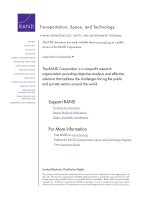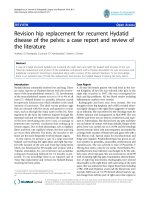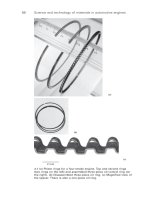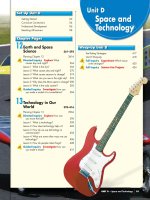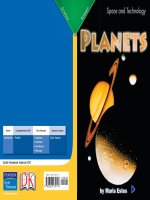- Trang chủ >>
- Khoa Học Tự Nhiên >>
- Vật lý
5 17 moon landings (space and technology)
Bạn đang xem bản rút gọn của tài liệu. Xem và tải ngay bản đầy đủ của tài liệu tại đây (4.52 MB, 14 trang )
Space and Technology
Genre
Nonfiction
Comprehension Skill
Make Inferences
Text Features
•
•
•
•
Captions
Call Outs
Diagrams
Glossary
Science Content
Earth and Space
Scott Foresman Science 5.17
ISBN 0-328-13966-1
ì<(sk$m)=bdjg i< +^-Ä-U-Ä-U
Vocabulary
Extended Vocabulary
asteroid
axis
comet
Moon phase
revolution
rotation
satellite
space probe
astronaut
colony
lunar
meteorite
module
seismograph
spacecraft
solar wind
volcano
Picture Credits
Every effort has been made to secure permission and provide appropriate credit for photographic material.
The publisher deeply regrets any omission and pledges to correct errors called to its attention in subsequent editions.
Photo locators denoted as follows: Top (T), Center (C), Bottom (B), Left (L), Right (R), Background (Bkgd).
2 Getty Images; 4 (C) NASA; 5 (TR) Novosti Photo Library/Photo Researchers, Inc., (BL) NASA; 8 (TR) NASA,
(CR) Marshall Space Flight Center/NASA; 10 NASA; 11 NASA; 14 NASA; 15 NASA; 18 NASA;
20 (BC) U.S. Space & Rocket Center; 21 NASA; 22 NASA.
Scott Foresman/Dorling Kindersley would also like to thank: Opener: NASA/DK Images; 1 NASA/DK Images;
4 (B) NASA/DK Images; 6 (BL) Euro Space Center, Transinne, Belgium/DK Images; 7 (R) Jet Propulsion Lab (JPL)/DK Images;
9 (TC) NASA/DK Images; 12 (CR) US Space & Rocket Centre, Huntsville, Alabama/DK Images; 13 (C) NASA/DK Images;
16 (C) NASA/DK Images; 17 (TR) NASA/DK Images; 19 (TC) NASA/DK Images; 20 (TR) NASA/DK Images.
Unless otherwise acknowledged, all photographs are the copyright © of Dorling Kindersley, a division of Pearson.
ISBN: 0-328-13966-1
Copyright © Pearson Education, Inc. All Rights Reserved. Printed in the United States of America.
This publication is protected by Copyright, and permission should be obtained from the publisher prior to any
prohibited reproduction, storage in a retrieval system, or transmission in any form by any means, electronic,
mechanical, photocopying, recording, or likewise. For information regarding permission(s), write to
Permissions Department, Scott Foresman, 1900 East Lake Avenue, Glenview, Illinois 60025.
3 4 5 6 7 8 9 10 V010 13 12 11 10 09 08 07 06 05
What did you learn?
1. What goal did President Kennedy propose
for space travel and how was it achieved?
2. What challenges did the astronauts on the
Apollo 13 mission face?
3. In what way has the technology developed
for space exploration affected our lives on
by Barbara Fierman
Earth?
4.
NASA scientists developed
special gear and equipment to help
astronauts exist and work on the Moon.
Write to describe the gear and equipment
the astronauts used. Use details from the
book to support your answer.
5.
Make Inferences How might the
experience of the Apollo 17 astronauts been
different from the Apollo 11 astronauts?
What You Already Know
The Earth moves in an elliptical path, or orbit,
around the Sun. This revolution takes about 365 days.
The Moon moves in an elliptical orbit around the Earth.
This revolution takes about twenty-eight days, just about one
month. The Earth rotates, or spins, on its axis. One rotation
takes about twenty-four hours, just about one day.
Our solar system consists of the Sun and its satellites.
These satellites include the nine planets, their moons, and
other smaller objects. Gravity holds these objects in their
orbits. Space probes have been sent from Earth to explore
the planets in our solar system.
People who use telescopes to view the solar system often
see comets. They appear as moving, fuzzy objects. A comet
is actually a frozen mass of ice, dust, and rock that orbits the
Sun. Each year, several comets travel in the solar system and
orbit the Sun.
2
Asteroids also revolve around the Sun and are often
referred to as minor planets. An asteroid is a mass of rock
that can be up to several hundred kilometers wide. Most
asteroids travel in the region between Mars and Jupiter.
The Moon is Earth’s nearest neighbor in the solar
system. It is located about 238,000 miles from Earth.
Each month, we see the Moon in different shapes, or
Moon phases. The different phases are due to the changing
shadow cast on the Moon by the Earth. Sometimes we see
the Moon as a whole circle, while at other times we see a
half circle, a crescent, or no Moon at all.
a view of Earth
from the Moon
3
In 1968, an Apollo spacecraft was launched into space.
The event marked the beginning of Moon exploration by
the United States.
The American people wanted to see the Moon close
up and explore it. They also wanted to keep up with the
progress being made by the U.S.S.R., the Union of Soviet
Socialist Republics. This Union was made up of Russia and
fourteen neighboring states.
The Soviets sent up the world’s first space probe, Sputnik,
in 1957. In 1961, a Soviet astronaut named Yuri Gagarin
orbited the Earth. The Soviets were even able to land a space
probe on the Moon.
On May 25, 1961, President John F. Kennedy gave a famous speech in
which he challenged Americans to send a person to the Moon.
4
John F. Kennedy was elected
President of the United States
in 1960. One of his goals was
to send the first humans to the
Moon by 1970. In his speech to
Congress on May 25, 1961, he
challenged Americans to make
his goal a reality.
Kennedy knew that the project
would be expensive and difficult. Luna 2 was the first space
probe to land on the Moon.
Scientists, engineers, pilots, and
doctors at the National Aeronautics
and Space Administration (NASA) led the effort.
NASA sent fact-finding missions into space. The purpose
of these missions was to gather information for the people
going to the Moon, so they would know what to expect.
NASA sent astronauts into Earth’s orbit and brought them
back safely during Project Mercury. In Project Gemini
astronauts practiced skills that would be needed for a Moon
mission. The project
that would send
astronauts to the
Moon and return
them safely to Earth
was called Apollo.
The Soviet Yuri Gagarin
was the first man in
space. On April 12, 1961,
he orbited the Earth in
the spaceship Vostok 1.
5
Reaching the Moon
service
module
first stage
command
module
second stage
third stage
spacecraft
The Saturn V rocket was the vehicle used to launch the
Apollo missions into space. It was the largest, most powerful
rocket ever launched by the United States. The rocket was
more than 363 feet high, taller than
a thirty-six story building! It was
Saturn V
designed as a disposable rocket, so
a new one had to be built for each
command
Apollo mission.
module
The Saturn V was made up of
service
three parts, or stages, stacked on top
module
of each other. When the fuel in one
lunar
stage was used up, it fell off and the
module
next stage took over. The first two
stages each had five rocket engines.
The third stage had only one.
6
On top of the Saturn V rocket were three
modules, or compartments. The command module
was the part where the crew lived. It was attached
to the service module, which held supplies and
the engines that were used once in orbit.
The lunar module was the part that
actually landed on the Moon.
Once in orbit, the astronauts
detached the lunar module from
the back of the service module. Then they
turned the spacecraft around and attached
the nose of the command module to the
lunar module. The service module’s engine
then pushed them out of Earth’s orbit.
Then the lunar module separated
from the rest of the craft and
landed on the Moon. When
the astronauts were done
exploring the Moon,
they flew back to the
command module.
The lunar module was
left behind, and the
astronauts traveled
back to Earth.
The Saturn V rocket
lifted the Apollo
spacecraft into orbit.
7
A Giant Leap
Two early missions,
Apollo 7 and 9, orbited
Earth and tested the parts
of the Apollo spacecraft.
Apollo 8 and 10 orbited the
Moon and photographed
the lunar surface. The
information gained from
these missions set the
Neil Armstrong was the first person
stage for the historic
to step onto the Moon.
Apollo 11 mission.
On July 16, 1969, a
Saturn V rocket launched Apollo 11
into space. Astronauts Neil Armstrong,
Edwin “Buzz” Aldrin, and Michael
Collins traveled in the command
module Columbia. As they neared
the Moon, Armstrong and
Aldrin crawled into the lunar
module Eagle. Collins stayed
aboard the Columbia and
orbited the Moon.
The Apollo 11 crew consisted of
mission commander Neil Armstrong,
command module pilot Michael
Collins, and lunar module pilot
Edwin “Buzz” Aldrin.
8
Neil Armstrong photographed
Buzz Aldrin stepping out of the
lunar module and onto the Moon.
The lunar module separated from
the command module and continued
toward the Moon. The excitement
back on Earth was high when
Armstrong announced, “The
Eagle has landed.”
More than 500 million
people watched by television
as Armstrong stepped out
onto the Moon’s surface.
They listened as he spoke these
now-famous words: “That’s
one small step for a man; one
giant leap for mankind.”
9
Armstrong and Aldrin planted a U.S. flag on the
Moon’s surface. Since there is no wind on the Moon,
they had to use a special flagpole to display the flag.
The astronauts spent about two and a half hours
exploring the Moon’s surface. They collected forty-four
pounds of rock and soil samples to bring back to Earth.
According to their descriptions, rocks of all sizes, shapes,
and textures are scattered on the Moon. The surface is
covered with a fine, gray dust. The dust is packed tightly,
however, so the men could walk on it and not sink in.
This photograph shows
Buzz Aldrin observing a
solar wind experiment.
When the astronauts finished
their work, they left their boots,
backpacks, and empty food
containers on the Moon. The Eagle’s
rocket blasted them off the Moon.
When they reached the Columbia,
they climbed in to travel back to
Earth with Collins. The Eagle was
allowed to float off into space.
As they approached the Earth,
the astronauts released the service
module into space and continued
to Earth in the command module.
Just five months before the deadline,
President Kennedy’s goal had been
achieved. Americans had walked
on the Moon and returned safely
to Earth.
10
Back to Earth
On the trip back to
Earth, the service
module separated
from the command
module Columbia.
The Columbia splashed
down into the Pacific
Ocean on July 24, 1969.
11
Moon Survival
Apollo astronauts needed
Spacesuit
spacesuits that were suitable
for flying in space and walking
on the Moon. Since the
Moon has no atmosphere, the
spacesuit needed to protect
the men from heat, cold, and
very low pressure. It also had
to supply them with oxygen,
since there is no air on the
Moon. The Apollo spacesuit
was made of many layers of
special fabrics. The spacesuit
and its backpack weighed
180 pounds on Earth, but
only 30 pounds on the Moon,
because gravity is not very
powerful there.
An inside layer was made of a lightweight
form of nylon. It had water-filled tubes
running through it that could be kept hot or
cold. This protected the astronauts from the
Moon’s extreme temperatures. The middle
layer was coated with a special
material to hold pressure.
Special overboots were designed
for walking on the Moon.
12
outer visor
with gold
coating
The outside layer was made of a tough material to help
the suit keep its shape. Since the suit was pressurized, it
needed this outer layer to keep it from blowing up like a
balloon. It also kept the suit from being torn, which would
have been extremely dangerous for the astronauts.
In addition to the spacesuits, astronauts wore boots,
gloves, and a helmet. When they walked on the Moon, they
added overboots and gloves with rubber fingertips. They also
wore visors over their helmets to protect their faces and eyes
from the Sun.
suit made
of highstrength
materials
overboot
Astronauts wore backpacks containing oxygen, cooling water,
and special equipment to remove carbon dioxide.
13
Later Landings
After the historic Apollo 11 mission, six more Apollo
missions were sent to explore the Moon. Five of these
missions, Apollo 12, 14, 15, 16, and 17, landed on the Moon.
Astronauts collected rock and soil samples, took photographs,
and set up experiments to learn more about the Moon.
Apollo 12 was actually hit by lightning just after it was
launched, but the astronauts and their equipment were fine.
Astronauts Charles Conrad and Alan Bean discovered the
Surveyor III, a probe that had been sent to the Moon two years
earlier. They used instruments called seismographs to measure
the movements of the Moon’s surface. These instruments also
provided information about moonquakes and the effects of
meteorites crashing onto the Moon.
On Apollo 14, astronauts sketched landmarks on the
Moon’s surface. They used these sketches to create maps
of the Moon. Apollo 15 astronauts traveled on the Moon’s
surface in the lunar roving vehicle, a small collapsible car, for
the first time. Astronauts
on Apollo 16 conducted
experiments to study
solar wind on the Moon.
In 1972, Apollo 17
made the last manned
lunar landing.
Apollo 17 astronaut Harrison
Schmitt uses special long-handled
tools to collect samples from the
Moon’s surface.
Apollo 12 astronaut
Alan Bean shows samples
from the Moon.
14
15
Near Disaster
Apollo 13 was launched on April 11, 1970. Astronauts
James Lovell, Fred Haise, and John Sweigert were ready for
the challenge of Moon exploration. On April 13, however,
their mission nearly turned into a disaster. One of their
oxygen tanks exploded. The explosion blew out one side
of the service module and caused damage to the other
oxygen tank.
The astronauts were in great danger. The spacecraft
gradually lost oxygen, electricity, lig ht, and water. The
astronauts were 200,000 miles away from Earth and had
to make quick decisions in order to stay alive.
NASA scientists on Earth kept in contact with
the Apollo 13 astronauts.
16
NASA scientists on the
ground worked quickly to
find a solution. They told
the Apollo 13 crew to move
into the lunar module and
use it as a kind of lifeboat.
The lunar module had not
been damaged during the
explosion, and it contained
enough water, oxygen, and
power for four days. The
After an oxygen tank exploded,
module’s engine had enough
the side of the service module
blew out, which resulted in a
power to send the crew back
toward the Earth. When they loss of fuel.
got close, they went back into the command module, which
was still attached to the lunar module. Only the command
module could keep the astronauts safe as they fell through
the atmosphere and landed in the ocean.
The three astronauts lost a total of thirty-one pounds,
and were tired, hungry, and dehydrated when they returned.
But they were alive and would be fine.
The Apollo 13 crew returned
to Earth in the command
module, which landed safely
on April 17, 1970.
17
Moon Buggy
communications antenna
hand control
On each of the last three
Apollo missions, astronauts
brought a lunar roving vehicle
(LRV) to the Moon. They used
the vehicle, also known as a Moon
Buggy, to travel around the Moon’s
surface. The Moon Buggy was
designed to travel in the Moon’s
environment.
In a Moon Buggy, the
astronauts could travel as far as six
miles away from the lunar module.
The vehicle could reach speeds of
eleven miles per hour.
The LRV’s frame had a
hinge in the middle so it
could be folded and stored
in the lunar module.
television
camera
The LRV
seating for two
astronauts
room for
equipment
and tools
Each Moon Buggy was battery operated and looked like
a golf cart. It was folded up and carried to the Moon in the
lunar module, and left on the Moon when the astronauts
returned to Earth.
Each Moon Buggy had two folding seats made of
aluminum and nylon webbing. An armrest was located
between the seats. Each seat had an adjustable footrest and
a seatbelt. The buggy was equipped with cameras and tools
to record information and gather samples.
Astronauts on the Apollo 15, 16, and 17 missions
drove the vehicle every day for each of the three days they
explored the Moon. In their reports they stated that the LRV
was both reliable and safe. It allowed the astronauts to travel
longer distances and gather more information than they
could have done without it.
18
19
Moon Discoveries
The Apollo missions provided valuable scientific
information and cleared up some of the mysteries
surrounding the Moon. For example, many people
believed that the surface of the Moon was like
quicksand. The missions showed that the fine
soil on the surface is actually well packed.
Astronauts gathered about 840 pounds
of rock and soil samples on the six trips
they made to the Moon. Geologists
analyzed the samples and learned that
the Moon is about 4.6 billion years
old, about the same age as Earth.
Soil samples from the Apollo 11
mission proved that plants could grow
Moon rock
in Moon soil as well as in Earth’s soil.
Scientists discovered that about three billion
years ago, active volcanoes existed on the Moon.
Hot lava spewed from the volcanoes and melted
over the Moon’s surface. Astronauts from Apollo
15 and 17 returned with samples of glass beads
that were created by volcanic eruptions. Today the
volcanoes are no longer active.
Scientists created new technologies for the Apollo
missions. Some of these technologies were later used in
the invention of personal computers, pocket calculators, and
cellular phones. Satellites that were developed for the space
program have helped predict weather and crop conditions.
Freeze-dried food that was developed for the astronauts is
now being used to feed disabled and elderly people.
Moon Tools
Astronauts used special
tools to collect and
store Moon samples.
tongs
20
sample
bag
scoops
sample container
Scientists examine samples collected on the Apollo 17 mission.
Astronauts spent seventy-five hours on the Moon, exploring
and collecting samples.
21
The Future
Do you think that people will return to the Moon to live
in the near future? Scientists are working to try to make this
possible. In 1998, the Lunar Prospector orbited the Moon
to search for ice on the Moon’s poles. Some experiments
have suggested that there may be billions of tons of ice on
the Moon. The discovery of ice would mean that settlers on
the Moon would have the water and oxygen necessary for
human life.
The first colony on the Moon might be a mining operation.
Satellites have identified important minerals on the Moon
that could be mined. The Moon could also be used as a base
for further exploration of the solar system.
This artist’s view of a lunar colony shows
special equipment to protect people
from the lack of air on the Moon.
22
President Kennedy’s dream of exploring the Moon
became a reality through the Apollo space program. Six
missions touched down on the Moon. Twelve astronauts
collected Moon samples. Scientists on Earth have analyzed
the samples. Perhaps the results of these missions will lead
to the development of Moon colonies in the future.
Apollo Missions
Apollo 7
1968 A manned Apollo mission; orbited the
Earth 163 times
Apollo 8
1968 A manned spaceship that orbited
the Moon
Apollo 9
1969 A manned test of the lunar module;
orbited the Earth 151 times
Apollo 10
1969 Mission orbited the Moon; dropped the
lunar module within nine miles of the Moon
Apollo 11
1969 First mission to land on the Moon;
astronauts took rock samples, planted flag
Apollo 12
1969 Mission was struck by lightning during
launch; landed on the Moon and returned
safely to Earth
Apollo 13
1970 Oxygen tank exploded; astronauts took
shelter in the lunar module; returned safely to
Earth in the command module
Apollo 14
1971 Astronauts conducted extensive
experiments on the Moon
Apollo 15
1971 Astronauts used lunar roving vehicle for
the first time
Apollo 16
1972 A three-day mission; astronauts again
drove the LRV
Apollo 17
1972 Last Apollo mission; astronauts stayed on
the Moon for about seventy-five hours
23
Glossary
Vocabulary
Extended Vocabulary
asteroid
axis
astronaut
comet
Moon phase
colony
revolution
rotation
lunar
satellite
space probe
meteorite
astronaut
colony
person trained
to go into space
lunar
meteorite
population of
living things or people
module
seismograph
having to dospacecraft
with the Moon
solar wind
a space rockvolcano
that crashes into a planet
or moon
module
a section of a spacecraft
seismograph
an instrument that measures the
movements of the ground
spacecraft
vehicle that travels beyond Earth and
into space
Picture Credits
Every effort has been made to secure permission and provide appropriate credit for photographic material.
The publisher deeply regrets any omission and pledges to correct errors called to its attention in subsequent editions.
solar wind
electrically charged particles released by
2 Getty Images; 4 (C) NASA; 5 (TR) Novosti Photo Library/Photo Researchers, Inc., (BL) NASA; 8 (TR) NASA,
the10 Sun
(CR) Marshall Space Flight Center/NASA;
NASA; 11 NASA; 14 NASA; 15 NASA; 18 NASA;
Photo locators denoted as follows: Top (T), Center (C), Bottom (B), Left (L), Right (R), Background (Bkgd).
20 (BC) U.S. Space & Rocket Center; 21 NASA; 22 NASA.
Scott Foresman/Dorling Kindersley would also like to thank: Opener: NASA/DK Images; 1 NASA/DK Images;
4 (B) NASA/DK Images; 6 (BL) Euro Space Center, Transinne, Belgium/DK Images; 7 (R) Jet Propulsion Lab (JPL)/DK Images;
9 (TC) NASA/DK Images; 12 (CR) US Space & Rocket Centre, Huntsville, Alabama/DK Images; 13 (C) NASA/DK Images;
16 (C) NASA/DK Images; 17 (TR) NASA/DK Images; 19 (TC) NASA/DK Images; 20 (TR) NASA/DK Images.
volcano
an opening in a planet’s surface through
which hot liquid rock is thrown up during
Unless otherwise acknowledged, all photographs
are the copyright © of Dorling Kindersley, a division of Pearson.
an eruption
ISBN: 0-328-13966-1
Copyright © Pearson Education, Inc. All Rights Reserved. Printed in the United States of America.
This publication is protected by Copyright, and permission should be obtained from the publisher prior to any
prohibited reproduction, storage in a retrieval system, or transmission in any form by any means, electronic,
mechanical, photocopying, recording, or likewise. For information regarding permission(s), write to
Permissions Department, Scott Foresman, 1900 East Lake Avenue, Glenview, Illinois 60025.
3 4 5 6 7 8 9 10 V010 13 12 11 10 09 08 07 06 05
24
What did you learn?
1. What goal did President Kennedy propose
for space travel and how was it achieved?
2. What challenges did the astronauts on the
Apollo 13 mission face?
3. In what way has the technology developed
for space exploration affected our lives on
Earth?
4.
NASA scientists developed
special gear and equipment to help
astronauts exist and work on the Moon.
Write to describe the gear and equipment
the astronauts used. Use details from the
book to support your answer.
5.
Make Inferences How might the
experience of the Apollo 17 astronauts been
different from the Apollo 11 astronauts?


